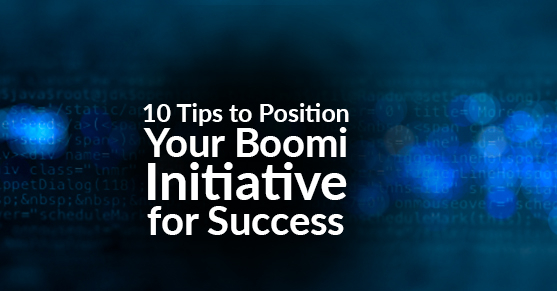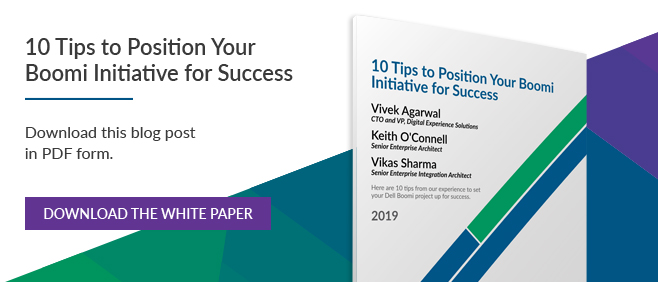The growth of a globalized economy and the increased pace of modern business has resulted in a highly competitive environment in which digital transformation and agility are becoming ever more critical. A critical component of a successful digital transformation is achieving nimble and seamless integration between your IT systems, whether your systems are on-premise or in the cloud. This is where Boomi comes in. In our opinion and that of analysts from Gartner and Forrester, Boomi is a best-of-breed integration Platform-as-a-Service or iPaaS. However, just like with every integration platform out there, the success of your Boomi integration project ultimately relies on a number of factors, and here are some tips on how to position your Boomi project for success:
- Understand the full breadth of capabilities offered by the Boomi platform
- Understand Boomi’s subscription pricing model
- Develop an overall system architecture and determine Boomi’s role in it
- Determine whether to use cloud-only, on-premise or hybrid deployment model
- Develop a phased project roadmap
- Align and involve key organizational resources
- Design your integration processes for reliability, accountability
- Establish and follow project standards
- Develop a test automation strategy for your Boomi implementation
- Prepare for go-live and operational phase
The rest of this article goes into each of these tips in more detail.
1. Understand the Full Breadth of Capabilities Offered by the Boomi Platform
The key to a digitally-driven company’s future is managing the flow of data through the organization by focusing on the interaction of people, process, and technology. Boomi delivers all of this in a unified platform composed of five main pillars; Boomi Integrate, Boomi Master Data Hub, Boomi Exchange, Boomi Flow, and Boomi Mediate. Each of these primary Boomi elements is designed both for ease of use and for scalability, providing streamlined tooling to allow you to build your data pipeline easily while leveraging all the advantages that a distributed system provides. Customers who embark on IT transformations using Boomi as their iPaaS are able to improve their staff productivity, save on infrastructure costs, and avoid the maintenance and licensing costs associated with their legacy software.

Digging a little further into the primary elements of the Boomi platform:
Integrate – At its core, Boomi is a powerful platform providing extensive application and process integration capabilities. The extensive Boomi library of integration connectors allows you to quickly and easily interact with in-house and external applications and services out-of-the-box.
Hub – The Master Data Hub provides a centralized service that allows you to consolidate and categorize master data from across your business.
Exchange – Boomi Exchange provides a full integration interface for connecting to your B2B partners, either through traditional EDI processes or through newer web-service-based flows.
Flow – Boomi Flow is a low-code application development and automation tool, allowing users to easily collect, transform, and ship information throughout your organization. Flow provides a way for you to rapidly create and deploy custom logic at the integration and process level.
Mediate – Boomi Mediate provides an enterprise-class API management solution, giving your organization the ability to create, publish, and scale API access to your data and processes both internally and externally.
2. Understand Boomi’s Subscription Pricing Model
While Boomi is a best-of-breed integration platform that offers many capabilities and advantages over legacy integration platforms, it is also crucial for you to understand the pricing model and take that into account before you make key Boomi architecture decisions. It is easy enough to get caught flat-footed if you skip over this crucial step, and make your executive team and project sponsor very unhappy about the ballooning financial investment for the Boomi platform. You should familiarize yourself with pricing for Boomi components such as Master Data Hub, Flow, and Connectors as well as how Boomi counts the number of system connections. It is a best practice to use a common folder for connections, to avoid duplication of connections and to promote connection reusability, and unnecessary usage of licenses. For example, when you create multiple connections in different folders for a single endpoint and use these connections in your process, each connection will consume a separate Boomi license even though it is connecting to the same endpoint.
3. Develop an Overall System Architecture and Determine Boomi’s Role in It
To fully leverage the Boomi platform, it is critical to think systematically about Boomi’s role in your overall enterprise system architecture rather than as a point solution. It is absolutely critical to plan out which specific features of the platform are going to be used, and how the platform will be positioned in your overall business pipeline. When it comes to Boomi, this translates to a simple set of questions:
- Which elements of the Boomi platform (application and data integration, master data hub, B2B/EDI, API management, and flow) will be used?
- Which Boomi components will be leveraged?
- Which Boomi connectors will be used?
- How will Boomi be positioned in the enterprise?
Digging into these questions, it’s important to have some basic context on the Boomi architecture and terminology. A Boomi component is a reusable entity within Boomi that captures an atomic process in your Boomi architecture; it is the basic unit that defines a workflow that moves data from one application to another. Mapping out which components will be used in your Boomi project is one of the most critical tasks during the architecture phase, and it is vital that you have a good understanding of how you want data to flow in your organization in order to answer this question successfully.
For the next question, Boomi Application Connectors and Technology Connectors are actually a type of component, but they are some of the most critical components in a Boomi project, as they provide an out-of-the-box way to integrate with third-party applications and services. Looking at the sources and destinations for data in your business, will help you to define which connectors you will use; for example, if you have information coming from Salesforce flowing through a data pipeline to Zuora, you will want to leverage the Salesforce and Zuora connectors to minimize the amount of custom development required at each end of the pipeline.
Finally, it’s important to determine how Boomi will be positioned in the context of your overall enterprise architecture. Who will own and manage your Boomi environments? Which team will maintain internal expertise on the platform to provide value to internal and external consumers of the Boomi product? What will be the overall governance model associated with the platform, and how will it be enforced? These are all questions that need to be answered as you plan your Boomi rollout.
4. Determine Whether to use Cloud-only, On-premise or Hybrid Deployment Model
One of the marquee features of the Boomi platform is that it provides both cloud-based and on-premise solutions which can be used on their own or in tandem in a hybrid model. This type of flexibility is critical for a product that’s positioned to be the glue between all of the processes in an organization; however, it does have an impact on the effort needed to plan for a Boomi project. In most cases, the decision of whether to go with a cloud-only, on-premise, or hybrid deployment model is fairly straightforward; if the services that Boomi will be connecting to are present in the cloud, i.e. Salesforce, Workday, or SuccessFactors, then the Boomi cloud solution is the correct choice. If the services being integrated are located on-premise, i.e. Siebel, SAP, a mainframe database, Hadoop, or Peoplesoft, then the on-premises deployment model is the correct path. If you are deploying a project that integrates both cloud-based and on-premise services, then you will need to architect a hybrid Boomi solution; luckily, the Boomi architecture makes this a straightforward process. Boomi’s modular architecture is designed to support a fully distributed architecture, enabled by the concept of a Boomi Atom. An Atom is essentially an encapsulated runtime that can be run anywhere, whether in the cloud, on-premise or even on client hardware. Scaling and high availability are provided by the Boomi Molecule, which is an automated cluster of Atoms. These architectural concepts make it straightforward to plan and deploy a Boomi application which maintains close proximity to your data sources and destinations, regardless of whether they’re in the cloud or on-premises.
5. Develop a Phased Project Roadmap
Any large-scale integration or data migration project can potentially affect a number of different organizational segments, and a typical Boomi project can involve a number of teams with concerns spanning the entirety of your organization. These types of projects can become overwhelming very quickly, and if you attempt to solve too many problems at one time, your project can wind up paralyzed by organizational conflict or inertia very quickly. Proper planning can help you avoid this issue; rather than allowing project scope to balloon, start off by identifying subsets of the overall project that can be readily scoped out, designed, and implemented using an iterative development approach. Selecting individual systems (for example, Salesforce and Netsuite) or specific concerns (for example, customer acquisition or order fulfillment) to concentrate on and deploy in a phased development approach allows you to reduce risk and quickly realize value from your Boomi investment.
6. Align and involve key organizational resources
Any large-or-medium scale Boomi project can potentially span a number of teams and even departments to develop and manage integrations across a number of systems. A key factor in achieving success is to engage and align stakeholders and team members from business, engineering, testing, operations, and compliance. A typical Boomi integration project has multiple workstreams: core integration process development, data governance, master data management, security, and API development/management with enterprise architecture oversight that spans these workstreams. When planning out a Boomi implementation, all teams that support services, applications, or processes that will integrate with the Boomi platform must be involved in architecture and implementation planning.
As with any integration project, data quality is key to success and having a robust data governance program and a master data management strategy in place is critical, or else you can end up with a garbage-in, garbage-out situation that can lead to a significant amount of re-work down the road, and may even result in the risk of lost or corrupt data.
7. Plan your implementation for observability, reliability, and accountability
For a Boomi implementation to provide value across the organization, it must provide a transparent, proactive process flow that integrates seamlessly into your existing organizational topology. Building a process support plan that leverages Boomi features to consistently provide feedback from insight on your integration processes is an important aspect of Boomi implementation planning. A good business support plan will cover the following Boomi features and highlight how business users and support personnel can expect to interact with the system as a whole:
- Notifications – Document expected notifications, when they are expected to occur, and what actions (if any) are required to resolve. Common notifications include transaction completion notifications, state change notifications, and workflow approval notifications.
- Error Handling – Make certain that potential sources of error or exception alarms are appropriately documented; also document what information sources (logs, metrics, etc.) are available to assist in root cause analysis for process and data errors.
- Disaster Recovery – Document the process used for recovery from a catastrophic system failure. Ensure that the overall system is resilient enough that recovery of an outage at any level is recoverable, and that the process used for system recovery is fully documented and tested.
8. Establish and follow project standards
For any major platform rollout, a bit of planning up-front can save you from major headaches down the road. When the platform rollout is an enterprise integration system that has the potential to act as the “glue” for processes and teams throughout your organization, that initial effort becomes critical to the success of the project, and ultimately, your business. Focusing on design best practices, naming and development guidelines, and overall performance and maintainability early on in the project’s planning stage will set your organization on the path to success; for a detailed set of XTIVIA’s Boomi Best Practices, see our Boomi Best Practices & Process Design Guidelines article.
9. Develop a test automation strategy for your Boomi implementation
As with any software development project, having a reliable testing plan can dramatically improve the overall quality and velocity of delivery; consistent testing also reduces the risk of regression issues sneaking into the project during implementation. Boomi’s platform architecture lends itself quite well to automated testing; its inherent componentization and atomic process structure make testing individual components quite straightforward. That being said, as Boomi is a data-oriented integration platform, there are some challenges that you can run into when trying to set up a comprehensive set of automated tests. Creating mock service endpoints that simulate the behavior of the real services can be of help here; essentially, you develop a test AtomSphere web service process that emulates the behavior that you expect from one of your integration points, and use it to simulate both successful and failed transactions to validate that your application behaves as expected in all scenarios. Sometimes, mocking a service just isn’t enough, and you need to test the actual data coming from the external service; in this case, it is critical to developing a test harness to handle any initialization and/or cleanup logic needed to sanitize the transaction data before and after the test run. Finally, as with any testing process, the test itself should be fully automated and should avoid any manually executed or interpreted actions; use of an automated testing tool such as Selenium or SoapUI can allow you to fully automate your testing process while giving you analytics around test runs.
10. Prepare for Go-Live and Operational Phase
Once the dust settles and the integration is live, the next step would be to clean up the build environment, make the integration processes “Maintenance-Ready,” document the Boomi integration processes, and train and hand off the system to the operations team. The overall project handoff plan should include provisions for the following:
- A set of “cleaned-up” Boomi processes, where redundant components have been removed, and naming and process structure is consistent from process to process.
- Documentation that describes the overall context, and specifics about what is different and unique about each process. Documentation need not describe each process in detail but should identify process and document properties, environment extensions, any extensive scripting, and error handling at a minimum. Additionally a separate document containing the exported main maps can be helpful even though the mappings are generally dynamic in nature. You can create this documentation in a spreadsheet identifying the version number with the disclaimer about confirming that the version number matches what is in the Boomi platform.
- One final but critical step is to organize a walk-through of the processes in the dev environment, and review of recent Process Reporting logs with the team that will be responsible for ongoing support and maintenance of the Boomi system and integration layer.
As a side note, I’d like to point out that one of the benefits of Boomi-based integration solutions becomes quite apparent at this step: scalability. Boomi solutions have scalability in spades, allowing you to start small with minimal upfront costs and grow steadily out from there, on the path to success!
Closing
Also, while this article focuses on tips that specifically relate to a Boomi-based integration project, you should incorporate general best practices that relate to just about any IT project of similar scale — these include getting the right level of executive support for a key enterprise-wide initiative, using a pragmatic agile SDLC that reduces risk, and ensuring that you have the right skills on your team to attain success. If you have questions on how you can best leverage Boomi and/or need help with your Boomi implementation, please engage with us via comments on this blog post, or reach out to us.





